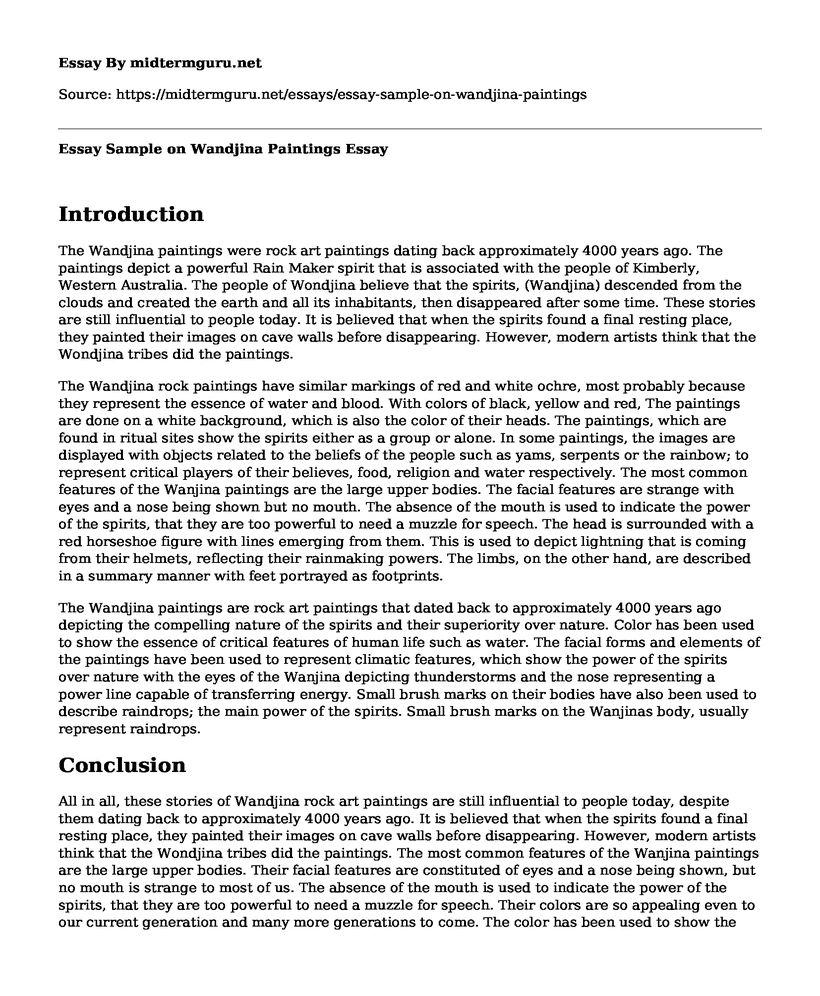Introduction
The Wandjina paintings were rock art paintings dating back approximately 4000 years ago. The paintings depict a powerful Rain Maker spirit that is associated with the people of Kimberly, Western Australia. The people of Wondjina believe that the spirits, (Wandjina) descended from the clouds and created the earth and all its inhabitants, then disappeared after some time. These stories are still influential to people today. It is believed that when the spirits found a final resting place, they painted their images on cave walls before disappearing. However, modern artists think that the Wondjina tribes did the paintings.
The Wandjina rock paintings have similar markings of red and white ochre, most probably because they represent the essence of water and blood. With colors of black, yellow and red, The paintings are done on a white background, which is also the color of their heads. The paintings, which are found in ritual sites show the spirits either as a group or alone. In some paintings, the images are displayed with objects related to the beliefs of the people such as yams, serpents or the rainbow; to represent critical players of their believes, food, religion and water respectively. The most common features of the Wanjina paintings are the large upper bodies. The facial features are strange with eyes and a nose being shown but no mouth. The absence of the mouth is used to indicate the power of the spirits, that they are too powerful to need a muzzle for speech. The head is surrounded with a red horseshoe figure with lines emerging from them. This is used to depict lightning that is coming from their helmets, reflecting their rainmaking powers. The limbs, on the other hand, are described in a summary manner with feet portrayed as footprints.
The Wandjina paintings are rock art paintings that dated back to approximately 4000 years ago depicting the compelling nature of the spirits and their superiority over nature. Color has been used to show the essence of critical features of human life such as water. The facial forms and elements of the paintings have been used to represent climatic features, which show the power of the spirits over nature with the eyes of the Wanjina depicting thunderstorms and the nose representing a power line capable of transferring energy. Small brush marks on their bodies have also been used to describe raindrops; the main power of the spirits. Small brush marks on the Wanjinas body, usually represent raindrops.
Conclusion
All in all, these stories of Wandjina rock art paintings are still influential to people today, despite them dating back to approximately 4000 years ago. It is believed that when the spirits found a final resting place, they painted their images on cave walls before disappearing. However, modern artists think that the Wondjina tribes did the paintings. The most common features of the Wanjina paintings are the large upper bodies. Their facial features are constituted of eyes and a nose being shown, but no mouth is strange to most of us. The absence of the mouth is used to indicate the power of the spirits, that they are too powerful to need a muzzle for speech. Their colors are so appealing even to our current generation and many more generations to come. The color has been used to show the essence of critical features of human life such as water. However, modern artists think that the Wondjina tribes did the paintings.
Reference
Kennedy, R., & Kelly, M. (2016). Australian Indigenous Design Charter: Communication Design. Protocols for sharing Indigenous knowledge in communication design practice.
Cite this page
Essay Sample on Wandjina Paintings. (2022, Dec 21). Retrieved from https://midtermguru.com/essays/essay-sample-on-wandjina-paintings
If you are the original author of this essay and no longer wish to have it published on the midtermguru.com website, please click below to request its removal:
- Essay on the Potentials and Pitfalls of the New Media
- Differences and Similarities Between Beethovens Piano Sonata 21 Op.53 and Eroica Symphony 3
- Analysis of Kurosawa's "Dreams" and Jim Jarmusch's "Coffee and Cigarettes"
- Essay Sample on Stories That Inspire Advocacy
- UX Design Graduate School: Personal Statement
- The Didot Logo Poster - Essay Sample
- Social Media Use: Benefits & Risks for People & Law Enforcement - Essay Sample







